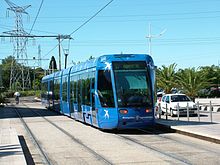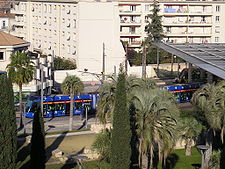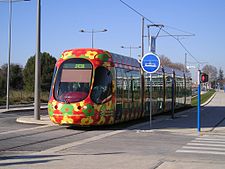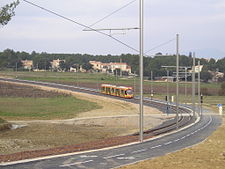- Montpellier tramway
-
Tramway de Montpellier 
Info Locale Montpellier, Languedoc-Roussillon Transit type Tram Number of lines 2 Number of stations 60 Daily ridership 190,000 (2008) Operation Began operation 2000 Operator(s) TAM Technical Track gauge 1,435 mm (4 ft 8 1⁄2 in) System map The city of Montpellier, France has a network of two tram lines currently in service, with a third line in construction. Responsibility for trams is held by the agglomeration community of the Montpellier agglomeration (Communauté d'agglomération Montpellier Agglomération), and trams are operated by the Transports de l'agglomération de Montpellier (TAM) authority.
The first line opened in July 2000 and the second line opened in December 2006. A third line at the construction stage, and is scheduled to open in 2012. In 2009, the city and municipal councils published proposals for a fourth line.
Contents
Line 1
 A Citadis 401 tram on line 1 through the city centre
A Citadis 401 tram on line 1 through the city centre
Line 1 is 15.2 km long and runs entirely within the city limits of Montpellier, going on a looping route from the northwest, through the city centre, and going to the east end of the city, terminating at Odysseum, a shopping and entertainment district. There are 27 stations on the line, with 7 major interchanges. Currently, ridership on the line averages 130,000 passengers per day, exceeding initial ridership projections of 75,000 passengers per day. The line was completed on a budget of €348.8 million. The line is coloured blue.
Line 1 opened on July 1, 2000. The Millénaire station opened on October 11, 2003, and the Malbosc station opened on November 18, 2003. A one-station extension opened on September 21, 2009 from the former Odysseum station, which was renamed Place de France, to a new Odysseum station which serves an additional shopping centre.
For the line, stations, station platforms, and urban improvements were done by architect Antoine Garcia-Diaz. The livery of trams on Line 1 was decorated in blue with white swallows by stylists Elizabeth Garouste and Mattia Bonetti. Each tram is named after a community member of the Montpellier agglomeration community.
Rolling stock
All rolling stock on line 1 is stored at the Les Hirondelles depot in the western district of La Paillade, which is located between the Saint-Paul station and the Hauts de Massane station. The rolling stock comprises 30 Citadis 401 trams and 3 Citadis 402 trams manufactured by Alstom.
Originally, Line 1 was operated with 28 3-section Citadis 301 trams with a length of 29.8 m. As ridership became successful on the line and trams had been filling up, between July 2002 and May 2003, the trams were extended from a length of 29.8 m and 3 sections to 40.9 m and 5 sections, and two additional Citadis 401 trams were delivered in January 2002, bringing the number of trams on Line 1 up to 30. The trams are numbered from 2001 to 2030.
In early 2007, three Citadis 302 trams, as used on Line 2, were delivered, and became operational for service on May 2, 2007. The three trams are numbered from 2031 to 2033. All trams on Line 1 have a width of 2.65 m.
Stations
- Mosson
- Halles de La Paillade
- Saint-Paul
- Hauts de Massane
- Euromédecine
- Malbosc
- Château d'Ô
- Occitanie (interchange with bus routes to northern communities in the Agglomeration)
- Hôpital Lapeyronie
- Universités des Sciences et des Lettres
- Saint-Éloi
- Boutonnet
- Stade Philippidès
- Place Albert 1er
- Louis Blanc
- Corum (interchange with Line 2 and bus routes to northeastern communities in the Agglomeration)
- Comédie
- Gare Saint-Roch (interchange with Line 2, bus routes at the bus station, and SNCF trains)
- Hôtel de Ville
- Antigone
- Léon Blum
- Place de l'Europe (interchange with Line 2)
- Rives du Lez (interchange with Line 2)
- Moularès
- Port Marianne (interchange with bus routes to southern communities in the Agglomeration)
- Mondial 1998 (projected station not expected to open until surrounding district is urbanized)
- Millénaire
- Place de France (formerly Odysseum) (interchange with bus routes to eastern communities in the Agglomeration)
- Odysseum
Future
There are plans for two further extensions of Line 1 in the future:
- An extension west from the Mosson terminus to a station on the future Line 3.
- An extension east from Odysseum.
Line 2
Line 2 opened for service on December 16, 2006. It is the longest tram line in France, with a length of 19.8 km and with 33 stations. The line is coloured orange. The Victoire 2 station opened April 16, 2007, being the 33rd station on the line. The line travels between Jacou in the northeast and Saint-Jean-de-Védas in the southwest, via Castelnau-le-Lez (on the boundary with Le Crès) and the centre of Montpellier. Line 2 was built at a cost of €450 million.
Part of Line 2, between Sabines and Saint-Jean-le-Sec, uses 2.5 km of an abandoned rail line. Line 2 is double tracked between Notre-Dame-de-Sablassou and Sabines; the remaining 3.5 km of the line is single tracked with passing loops.
As with Line 1, stations, station platforms, and urban improvements on Line 2 were done by architect Antoine Garcia-Diaz. The livery of trams on Line 2 is decorated in orange with flowers by Mattia Bonetti. Each tram is named for a historic person in the Montpellier region.
Rolling stock
Trams on Line 2 are stored at the La Jeune Parque depot, located near the Sabines station.
The rolling stock on Line 2 comprises 24 Citadis 302 trams manufactured by Alstom, with a length of 32.5 m, a width of 2.65 m, and five sections. The trams were delivered between March 2006 and February 2007 and are numbered from 2041 to 2064.
Stations
Line 2 tramway in Saint-Jean-de-Védas. Line 2 in Castelnau-le-Lez along bicycle path.
Line 2 in Castelnau-le-Lez along bicycle path.
- Jacou (interchange with a suburban bus route to the northeast)
- Georges Pompidou (interchange with suburban and departmental bus routes to the northeast)
- Via Domitia
- Aube Rouge
- Notre-Dame-de-Sablassou (partial terminus; interchange with bus routes to the northeast of the Agglomeration and the east of the Department of Hérault)
- Centurions
- La Galine
- Clairval
- Charles de Gaulle (interchange with suburban bus routes)
- Saint-Lazare
- Aiguelongue
- Jeu de Mail des Abbés
- Beaux-Arts
- Corum (interchange with Line 1 and bus routes to northeastern communities in the Agglomeration)
- Les Aubes
- Pompignane
- Place de l'Europe (interchange with Line 1)
- Rives du Lez (interchange with Line 1)
- Voltaire
- Place Carnot
- Gare Saint-Roch (interchange with Line 1, bus routes at the bus station, and SNCF trains)
- Rondelet
- Nouveau Saint-Roch
- Saint-Cléophas (interchange with a suburban bus route to the south)
- Lemasson
- Mas Drevon
- Croix d'Argent
- Villeneuve d'Angoulême
- Sabines (partial terminus; interchange with suburban and departmental bus routes to the south; parking; track connections to the La Jeune Parque depot)
- Les Grisettes (located in the Mas d'Astre industrial park; opening subject to urbanization of the district)
- Victoire 2
- La Condamine
- Saint-Jean-le-Sec (interchange with departmental bus routes to the west)
- Amphitrite (expected to open following the urbanization of the ZAC de Roque-Fraisse)
- Saint-Jean-de-Védas Centre (interchange with suburban bus routes to the west)
Line 3
A third tram line, Line 3, is in preparation, with a length of 22.4 km and 32 stations. The line is expected to be coloured green. This is a preview of the route:
- The line will start in Juvignac, in a new district, Caunelles, in the north of the village.
- In Montpellier, Line 3 will parallel the Mosson.
- The line will go through neighbourhoods in the west end of the city. A part of this segment will loop to the north to serve the Alco neighbourhood.
- Next, there will be a connection to the existing Line 1 and Line 2 at Gare Saint-Roch.
- After passing Gare Saint-Roch, the line will form a semicircle to serve southern neighbourhoods of the city. Part of this route will share track with the existing Line 2 between Gare Saint-Roch and Nouveau Saint-Roch.
- There will be an interchange with the existing Line 1 at Port Marianne, then the line will travel southeast on Avenue de la Mer and Route de Carnon, and split with a branch to Lattes and a branch to Pérols.
- In the community of Lattes, the branch will split from a station in the community of Boirargues, going on its own right-of-way to the centre of Lattes.
- In the community of Pérols, the branch will run in its own right-of-way parallel to Route de Carnon to a terminus in the southeast of Pérols. The terminus is 800 metres from the Mediterranean Sea.
Line 3 is expected to open in 2012, and expected to cost €450 million. Trams on Line 3 will be designed with an underwater theme by designer Christian Lacroix.
Line 4
In June 2009, plans for a fourth line were published. The line will run from the rugby stadium Yves du Manoir in the south west of the city, via the Promenade du Peyrou, and up towards the suburb of Clapiers, northeast of Montpellier.
See also
- Transportation in Montpellier
- Trams in France
- List of town tramway systems in France
External links
- (French) TAM official site
- (English) Description on Trams-In-France.net
Urban guided transit systems in France Métros PresentTramways PresentPlannedFormerAvranches · Bordeaux · Cannes · Caen · Grenoble · Deauville · Fontainebleau · Le Havre · Lyon · Nantes · Nice et Littoral · Paris · Rouen · Saint-Romain-de-Colbosc · Strasbourg · Valenciennes · VersaillesGuided buses PresentPlannedDouai · ParisUrban funiculars PresentFormerBesançonUrban cable cars PresentGrenoblePeople movers PresentSee also: Transport in France, List of railways in France, Trams in France, and Railways in FranceCategories:- Tram transport in France
- Montpellier
Wikimedia Foundation. 2010.





